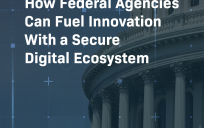After years spent as a buzzword, cloud has finally solidified itself as a central component in federal, state and local government agencies around the country. More than 60 percent of public-sector IT leaders believe that cloud is essential to digital transformation.
Despite the consensus, there are still doubts about whether the cloud is right for every agency, the best method to adopt it, how to use it most efficiently and more. And reasonably so. As a new technology, agencies want to make sure that they’re adopting cloud in the right ways so that they can improve the work they do as efficiently as possible.
To get a better understanding of the importance of cloud and how best to introduce it into government agencies, GovLoop spoke with Brannan Matherson, Director of Product Marketing, CenturyLink, and John MacKinnon, Global Telecommunications Partner Development Manager, Worldwide Public Sector, Amazon Web Services, during a recent online training.
“There are a lot of government agencies, NPOs [nonprofits], education institutions that have decided to go into the cloud to innovate,” MacKinnon said, clarifying the importance of cloud adoption. “It’s a transformative process.” He emphasized cloud’s importance to research and education, citizen services and engagement, economic development, and more.
Matherson echoed that point, but also made sure to address concerns that agencies have regarding cloud adoption.
“Implementing the cloud can be a large undertaking, especially for state and local governments,” he said. “But government agencies have a much simpler path to taking advantage of cloud services. There’s a simplicity and ease of adoption that can expedite the journey to the cloud.”
The simplicity that Matherson refers to comes as a result of a partnership between AWS and CenturyLink in the form of NASPO ValuePoint, a cloud solution that combines the best of both companies.
Adopting the cloud through this partnership provides a single, consistent platform that enables connectivity to the various cloud destinations that an agency may want to leverage. Matherson notes that it provides visibility and insight to agencies working to build a cloud infrastructure.
“It’s getting easier for government to adopt cloud,” Matherson said. “It’s become a critical component of IT as more services are being requested by agencies.”
MacKinnon made it clear that moving to cloud isn’t an all-or-nothing choice. Agencies are able to incorporate the aspects that they want without having to go through unnecessary change. He referred to the structure as a “use-as-you-need, pay-as-you-go” model.
“The deeper aspect is how do we work with our partner to make sure they’re maximizing security and spending in the cloud,” Mackinnon said. Matherson added that they can help agencies identify risks ahead of adoption to resolve any problems proactively to make the process smooth.
“We provide optimization and analytics to help unlock optimal areas to allocate your spend,” Matherson said. “It’s a clear left-to-right view of overall cost and financial impact.”
Once cloud has been implemented, AWS continues to provide service to agencies in the form of an AWS technical account manager. From consulting to implementation to servicing and back, the entire cloud process is covered.
Adopting and maintaining cloud correctly is incredibly important to agencies, as it is a still-growing technology that requires attention to its ever-changing capabilities.







Leave a Reply
You must be logged in to post a comment.